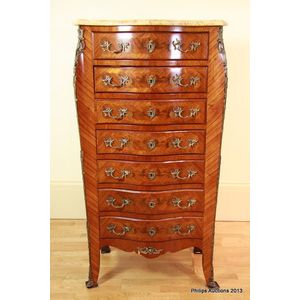Louis XV Style Walnut Semainier with Marble Top
You must be a subscriber, and be logged in to view price and dealer details.
Subscribe Now to view actual auction price for this item
When you subscribe, you have the option of setting the currency in which to display prices to $Au, $US, $NZ or Stg.
- Herringbone Pattern in Furniture - The herringbone pattern is a popular decorative pattern used in furniture, created by inlaying small rectangular pieces of veneer in a zig-zag pattern, similar to the pattern found in the herringbone link used in jewellery. The pieces of veneer are cut at a 45-degree angle to create the distinctive V-shape, and are arranged in a way that creates a seamless, interlocking pattern.
The herringbone pattern in veneer can be used in a variety of ways in furniture design. It is commonly used on table tops, cabinet doors, and other flat surfaces, where it can add visual interest and texture to the piece. It can also be used on curved surfaces, such as the front of a chest of drawers or the top of a curved console table, where it can create a dramatic and eye-catching effect. - Satinwood - Satinwood is a dense pale gold coloured timber that was imported into Britain in the second half of the 18th century, and early 19th centuries from the East Indies and the West Indies. The name derives from the satin-like surface sheen when the timber is polished.
It was used in the solid, as a veneer and in inlays. As well as furniture, satinwood was used for making musical instruments, barometers, boxes and clocks.
It will usually be found on only the very best quality objects, presumably because of of its cost at the time. - Serpentine - Resembling a serpent, in the form of an elongated 'S'. A serpentine front is similar to a bow front, except that the curve is shallow at each end, swelling towards the middle. The term presumably derives from its similarity to a moving snake or serpent. Serpentine fronts are usually veneered, with the carcase either being cut and shaped from a solid piece of timber, or built in the 'brick' method.
- Stringing - Fine inlaid lines, in contrasting colour to the carcase timber, found mainly on furniture made in the styles of the later 18th and early 19th centuries. Stringing, which may be of satinwood, pine, ebony, horn, brass or occasionally ivory, is found principally on drawer fronts, around the outer edges of usually tapered legs and French bracket feet, around the edges of inlaid panels and between the joint of the cross banding and carcase timber on table tops, chests of drawers, cabinets etc. The effect is to emphasize the line of the piece and add to the impression of lightness and elegance. Stringing also occurs in Sheraton-revival-style furniture of the later 19th and early 20th centuries.
- Escutcheons - An escutcheon is a plate, made of brass, wood, ivory or ebony, which fits into or over the h keyhole, to protect the edge of the timber keyhole from damage by continual insertions of the key. As a general rule you would expect these escutcheons to be sympathetic in design to the handles of the piece. From the early 19th century escutcheons were sometimes made from ivory, ebony, bone or contrasting wood, often cut in a diamond or shield shape and inlaid into the front. Ivory, in particular, will tend to discolour with age, and certainly should not show up as brilliantly white.
- Parquetry - Parquetry is inlay laid in geometric patterns, the contrast being achieved by the opposing angles of the grain and veneers. The herringbone pattern is the most commonly used in flooring, but this is almost never seen in furniture - the patterns used are more complex and unlike flooring, can include several different varieties of timber.
- Inlay - Decorative patterns inserted into the main body of a piece of furniture, generally in wood of contrasting colour and grain, though brass, ivory, ebony, shell and sometimes horn have been used. Inlay may consist of a panel of well figured timber inset into a cabinet door front, geometric patterns, or complex and stylized designs of flowers, swags of foliage, fruits and other motifs. As a general rule, in pieces where the carcase is constructed in the solid, the inlay is relatively simple such as stringing, cross banding and herringbone banding. Where more elaborate and decorative work was required veneer was used. Inlay has been fashionable from at least the latter half of the 17th century, when a variety of elaborate forms were developed
- Foliate - Decorated with leaves or leaf-like forms.
This item has been included into following indexes:
Visually similar items

A French Louis VX style walnut serpentine shaped seven drawer marble top tall chest. 141 cm high, 82 cm wide, 45 cm deep

A French walnut Louis XV-style chest of drawers, first half 20th century, a serpentine cream and purple marble top above five full-width draws each with feather banding and floral inlay within shaped reserves, feather veneered panels to the sides, with a s

A French Louis XV style commode. Bombe shape with a rouge marble top, above three drawers with ormolu mounts. 85 cm high, 132 cm wide, 59 cm deep

A transitional style tulipwood marquetry chest, early 20th century, with a serpentine mottled yellow ochre marble top above five drawers of conforming profile with reserved and floral inlaid panels, feather banded panels to the sides, bold hipped edges and
